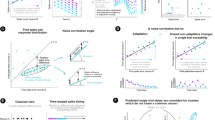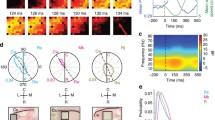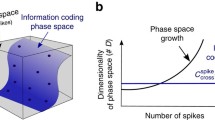Abstract
When the same visual stimulus is presented across many trials, neurons in the visual cortex receive stimulus-related synaptic inputs that are reproducible across trials (S) and inputs that are not (N). The variability of spike trains recorded in the visual cortex and their apparent lack of spike-to-spike correlations beyond that implied by firing rate fluctuations, has been taken as evidence for a low S/N ratio. A recent re-analysis of in vivo cortical data revealed evidence for spike-to-spike correlations in the form of spike patterns. We examine neural dynamics at a higher S/N in order to determine what possible role spike patterns could play in cortical information processing. In vivo-like spike patterns were obtained in model simulations. Superpositions of multiple sinusoidal driving currents were especially effective in producing stable long-lasting patterns. By applying current pulses that were either short and strong or long and weak, neurons could be made to switch from one pattern to another. Cortical neurons with similar stimulus preferences are located near each other, have similar biophysical properties and receive a large number of common synaptic inputs. Hence, recordings of a single neuron across multiple trials are usually interpreted as the response of an ensemble of these neurons during one trial. In the presence of distinct spike patterns across trials there is ambiguity in what would be the corresponding ensemble, it could consist of the same spike pattern for each neuron or a set of patterns across neurons. We found that the spiking response of a neuron receiving these ensemble inputs was determined by the spike-pattern composition, which, in turn, could be modulated dynamically as a means for cortical information processing.
Similar content being viewed by others
References
Baker SN, Lemon RN (2000) Precise spatiotemporal repeating patterns in monkey primary and supplementary motor areas occur at chance levels. J. Neurophysiol. 84: 1770–1780.
Beierholm U, Nielsen CD, Ryge J, Alstrom P, Kiehn O (2001) Characterization of reliability of spike timing in spinal interneurons during oscillating inputs. J. Neurophysiol. 86: 1858– 1868.
Bi GQ, Poo MM (1998) Synaptic modifications in cultured hippocampal neurons: dependence on spike timing, synaptic strength, and postsynaptic cell type. J. Neurosci. 18: 10464–10472.
Brecht M, Schneider M, Sakmann B, Margrie TW (2004) Whisker movements evoked by stimulation of single pyramidal cells in rat motor cortex. Nature 427: 704–710.
Brette R, Guigon E (2003) Reliability of spike timing is a general property of spiking model neurons. Neural Computation. 15: 279–308.
Brunel N, Chance FS, Fourcaud N, Abbott LF (2001) Effects of synaptic noise and filtering on the frequency response of spiking neurons. Phys. Rev. Lett. 86: 2186–2189.
Bryant HL, Segundo JP (1976) Spike Initiation by Transmembrane current: A white-noise analysis. J. Physiol. 260: 279– 314.
Buracas GT, Zador AM, DeWeese MR, Albright TD (1998) Efficient discrimination of temporal patterns by motion-sensitive neurons in primate visual cortex. Neuron 20: 959–969.
Cecchi G, Sigman M, Alonso J, Martinez L, Chialvo D, Magnasco M (2000) Noise in neurons is message dependent. Proc. Natl. Acad. Sci. 97: 5557–5561.
Coombes S, Bressloff PC (1999) Mode locking and Arnold tongues in integrate-and-fire neural oscillators. Phys. Rev. E. 60: 2086–2096.
Cossart R, Aronov D, Yuste R (2003) Attractor dynamics of network UP states in the neocortex. Nature 423: 283–288.
Dayan P, Abbott LF (2001) Theoretical Neuroscience. MIT Press, Cambridge.
de Ruyter van Steveninck RR, Lewen GD, Strong SP, Koberle R, Bialek W (1997) Reproducibility and variability in neural spike trains. Science 275: 1805–1808.
Deweese MR, Zador AM (2004) Shared and private variability in the auditory cortex. J. Neurophysiol. 92: 1840–1855.
Fellous JM, Houweling AR, Modi RH, Rao RPN, Tiesinga PHE, Sejnowski TJ (2001) Frequency dependence of spike timing reliability in cortical pyramidal cells and interneurons. J. Neurophysiol. 85: 1782–1787.
Fellous J-M, Thomas PJ, Tiesinga PH, Sejnowski TJ (2004) Discovering spike patterns in neuronal responses. J. Neurosci. 24: 2989–3001.
Fourcaud-Trocme N, Hansel D, van Vreeswijk C, Brunel N (2003) How spike generation mechanisms determine the neuronal response to fluctuating inputs. J. Neurosci. 23: 11628– 11640.
Gardiner CW (1985) Handbook of Stochastic Methods, 2nd edition. Springer, Berlin.
Gerald CF, Wheatley PO (1999) Applied Numerical Analysis, 6th edition. Addison-Wesley, Reading, California.
Gutkin B, Ermentrout GB, Rudolph M (2003) Spike generating dynamics and the conditions for spike-time precision in cortical neurons. J. Compu. Neurosci. 15: 91–103.
Haas JS, White JA (2002) Frequency selectivity of layer II stellate cells in the medial entorhinal cortex. J. Neurophysiol. 88: 2422–2429.
Hunter J, Milton J, Thomas P, Cowan J (1998) Resonance effect for neural spike time reliability. J. Neurophysiol. 80: 1427–1438.
Hunter JD, Milton JG (2003) Amplitude and frequency dependence of spike timing: Implications for dynamic regulation. J. Neurophysiol. 90: 387–394.
Ikegaya Y, Aaron G, Cossart R, Aronov D, Lampl I, Ferster D, Yuste R (2004) Synfire chains and cortical songs: Temporal modules of cortical activity. Science 304: 559–564.
Izhikevich EM, Gally JA, Edelman GM (2004) Spike-timing Dynamics of Neuronal Groups. Cereb Cortex. 14: 933–944.
Jensen RV (1998) Synchronization of randomly driven nonlinear oscillators. Phys. Rev. E. 58: R6907–R6910.
Jensen RV (2002) Synchronization of driven nonlinear oscillators. Amer. J. Phys. 70: 607–619.
Knight BW (1972a) Dynamics of encoding in a population of neurons. J. Gen. Physiol. 59: 734–766.
Knight BW (1972b) The relationship between the firing rate of a single neuron and the level of activity in a population of neurons. Experimental evidence for resonant enhancement in the population response. J. Gen. Physiol. 59: 767–778.
Koch C (1999) Biophysics of Computation. Oxford: Oxford University Press.
Mainen Z, Sejnowski T (1995) Reliability of spike timing in neocortical neurons. Science 268: 1503–1506.
Markram H, Lubke J, Frotscher M, Sakmann B (1997) Regulation of synaptic efficacy by coincidence of postsynaptic APs and EPSP. Science 275: 213–215.
Nowak LG, Sanchez-Vives MV, McCormick DA (1997) Influence of low and high frequency inputs on spike timing in visual cortical neurons. Cereb Cortex 7: 487–501.
Oram MW, Wiener MC, Lestienne R, Richmond BJ (1999) Stochastic nature of precisely timed spike patterns in visual system neuronal responses. J. Neurophysiol 81: 3021–3033.
Reinagel P, Reid R (2000) Temporal coding of visual information in the thalamus. J. Neurosci. 20: 5392–5400.
Reinagel P, Reid RC (2002) Precise firing events are conserved across neurons. J. Neurosci. 22: 6837–6841.
Reyes AD (2003) Synchrony-dependent propagation of firing rate in iteratively constructed networks in vitro. Nat. Neurosci. 6: 593–599.
Risken H (1989) The Fokker-Planck Equation, 2nd edition. Springer, Berlin.
Ritt J (2003) Evaluation of entrainment of a nonlinear neural oscillator to white noise. Phys. Rev. E. 68: 041915.
Rudolph M, Destexhe A (2003) Tuning neocortical pyramidal neurons between integrators and coincidence detectors. J. Comput. Neurosci. 14: 239–251.
Schreiber S, Fellous JM, Tiesinga P, Sejnowski TJ (2004) Influence of ionic conductances on spike timing reliability of cortical neurons for suprathreshold rhythmic inputs. J. Neurophysiol. 91: 194–205.
Shepherd G (1998) Synaptic Organization of the Brain, 4th ed.
Szucs A, Vehovszky A, Molnar G, Pinto RD, Abarbanel HD (2004) Reliability and precision of neural spike timing: simulation of spectrally broadband synaptic inputs. Neurosci. 126: 1063– 1073.
Tiesinga P, Fellous J-M, Salinas E, Jose JV, Sejnowski T (2004) Synchronization as a mechanism for attentional gain modulation. Neurocomput. 58-60: 641–646.
Tiesinga PHE (2002) Precision and reliability of periodically and quasiperiodically driven integrate-and-fire neurons. Phys. Rev. E. 65: Art. no. 041913.
Tiesinga PHE (2004) Chaos-induced modulation of reliability boosts output firing rate in downstream cortical areas. Phys. Rev. E. 69: 031912.
Tiesinga PHE, Jose JV (2000) Robust gamma oscillations in networks of inhibitory hippocampal interneurons. Network-Comput. Neural Syst. 11: 1–23.
Tiesinga PHE, Fellous JM, Sejnowski TJ (2002) Attractor reliability reveals deterministic structure in neuronal spike trains. Neural Comput. 14: 1629–1650.
Toups JV, Fellous J-M, Tiesinga P (2004) Statistical validation of spike patterns revealed by fuzzy clustering algorithms. 2004 Abstracts Society for Neuroscience: 984.922.
Wang XJ, Buzsaki G (1996) Gamma oscillation by synaptic inhibition in a hippocampal interneuronal network model. J. Neurosci. 16: 6402–6413.
Zhang LI, Tao HW, Holt CE, Harris WA, Poo M (1998) A critical window for cooperation and competition among developing retinotectal synapses. Nature. 395: 37–44.
Author information
Authors and Affiliations
Rights and permissions
About this article
Cite this article
Tiesinga, P.H.E., Toups, J.V. The Possible Role of Spike Patterns in Cortical Information Processing. J Comput Neurosci 18, 275–286 (2005). https://doi.org/10.1007/s10827-005-0330-2
Received:
Revised:
Accepted:
Issue Date:
DOI: https://doi.org/10.1007/s10827-005-0330-2




